
World Cruise: Sydney to New York Voyage
Cunard
Labyrinth-like souks and marble-encased mosques vie to be explored in Oman's capital, Muscat. Cadiz, meanwhile, offers the perfect gateway to discover Jerez, birthplace of the famous Spanish sherry.

Executive Member Benefit
Executive Members receive an annual 2% Reward, up to $1,250, on qualified Costco Travel purchases
Digital Costco Shop Card
Member Exclusive: Digital Costco Shop Card with every Cunard sailing†
Sailing Itinerary

Note: Cruise itineraries are subject to change. Please verify ports and times directly with the cruise line.
Overview
Sydney is Australia's largest and most cosmopolitan city and is the capital of New South Wales, the most heavily populated state of Australia. Sydney is situated on one of the world's most beautiful and famous harbors. Sydney also boasts beautiful beaches, fantastic shops, restaurants, history and culture. Sydney's many highlights include the Harbors Bridge, the Opera House, Centrepoint Tower, The Rocks, the stunning harbor, and the white sands of Bondi, Manly, and beyond. Sydney is also home to beautiful National Parks, the Royal Botanic Gardens, many harborfront picnic locations, and heritage areas.
Overview
Sydney is Australia's largest and most cosmopolitan city and is the capital of New South Wales, the most heavily populated state of Australia. Sydney is situated on one of the world's most beautiful and famous harbors. Sydney also boasts beautiful beaches, fantastic shops, restaurants, history and culture. Sydney's many highlights include the Harbors Bridge, the Opera House, Centrepoint Tower, The Rocks, the stunning harbor, and the white sands of Bondi, Manly, and beyond. Sydney is also home to beautiful National Parks, the Royal Botanic Gardens, many harborfront picnic locations, and heritage areas.
Overview
Brisbane, the capital city of Queensland, is midway up the east coast of Australia - 27.5oS, 153oE. With the Gold Coast to the south and the Sunshine Coast to the north, as domestic and international airports, Brisbane is an ideal headquarters for an Australian holiday. Brisbane, indeed all of Queensland, operates on Eastern Standard Time which is 10 hours ahead of GMT. Summertime or Daylight Saving is not observed. Residents and visitors to Brisbane enjoy a wide range of landscapes and lifestyles. The inner-city, metropolitan Brisbane is surrounded by leafy, sometimes very hilly, suburbs. Further out in the suburbs, the traditional Australian house on a large block or even acreage dominates. Moreton Bay and its islands provide water sports, sailing, and seaside suburbs. The Pacific Highway leads south to the Gold Coast and its well-known surf beaches. North is the seaside town of Redcliffe, the rainforest and picturesque countryside of Pine Rivers, Caboolture, and the Glasshouse Mountains. Bribie Island offers the first surf beach to the north. The Sunshine Coast towns and hinterland are popular holiday spots. Traveling west of Brisbane, past Ipswich, you soon climb the Great Dividing Range to Toowoomba and the rich plains of the Darling Downs.
Overview
Yorkeys Knob is the most central beach of Cairns Northern Beaches located right in between Cairns and Palm Cove. Yorkeys Knob is a great beach for adventure enthusiasts and active travelers who want to escape the tourist-dense hotspots associated with many other beaches around Cairns.
Overview
Darwin - Capital City of the Northern TerritoryWhere Asia meets the DreamtimeAn exciting, eclectic mixture of cultures place that is truly uniquely Australian while being home to more than 60 different nationalities, and people who come from all continents of the globe. A focus on festivals, food and fashion.A sporting centre, home to the Darwin Cup, the Arafura Games and more and more exciting national and international sporting events City - Set on a rocky peninsula reaching into one of the most beautiful natural harbours on the north Australian coast. Elevated above the cliffs, surrounded by water on three sides, a city fanned by soft cool breezes that contribute to its tropical charm. The tropical climate encourages outdoor living and locals and visitors alike take advantage of this lifestyle to stroll through Darwin's leafy streets, browsing through the art galleries and enjoying cafe life, discovering little hidden corners of the city. The contrasts are exquisite. A Chinese temple with its statues of the Immortals, the smoke from incense drifting slowly upward, lies only twenty metres behind busy Cavenagh St but exists in a different world, timeless and peaceful. Darwin - a city of contrasts and tempting tastes. Where shady parks suitable for quiet contemplation lie only metres from streets full of shoppers, the smells of food drift on the air from sizzling grills, flaming woks and bubbling saucepans. Darwin - take time to enjoy its wonderful trees that surprise our visitors, exotic flowering trees, frangipani, Pride of India and poincianas, the shady rain trees, banyan and tamarind trees delight the senses and leave images of a truly tropical city. Darwin - A city destroyed three times - first by the cyclone of 1893, then by the bombs of World War II, next by Cyclone Tracy. The spirit of survival is undiminished, Darwin has grown and developed to become the modern city of today, a monument to the tenacity and courage of its people.
Overview
Bitung is a city on the northern coast of the island of Sulawesi in Indonesia. It is in the province of North Sulawesi and faces Lembeh Island and the Lembeh Strait, which is known for its colorful marine life, in particular sea slugs.
Overview
Hong Kong is a place of contrasts. Sleek, glassy skyscrapers shine above Old World markets where chicken feet and dried squid are displayed for sale. Archaic wooden boats bob past sleek cruise liners. Subway stations and expressway interchanges dot a landscape cluttered with Rolls Royce and rickshaws. Hong Kong Island was ceded to Britain in 1842 when those serving the British crown attacked the island. Though it was deeded back to China in 1997, Hong Kong enjoys a high degree of autonomy, especially in its economy and municipal government. Hong Kong is one of the most unique Chinese cities in the world. The 417-square-mile island off the coast of China offers visitors a slice of authentic Chinese culture with all the amenities of home. A modern metropolis teeming with Eastern and Western influences, Hong Kong is the world's third-largest financial center, the so-called “Wall Street of Asia,” and a shopping gold mine. Shopping? Yes indeed. Hong Kong is a duty-free port and the world's leading exporter of toys, garments, watches, and electronics. As a result, the vast majority of the 10 million annual visitors come with an empty suitcase that they fill up after visiting the malls, street bazaars (Stanley Market is world famous), textile and tailor shops, and jade and electronic stores. Those willing to look beyond the bargain-basement prices will find that Hong Kong is more than the world’s largest department store – it’s a cultural Mecca with wining and dining, museums, and historic attractions. Be sure to ride the world-famous Star Ferry across the harbor to Hong Kong Island, admire the mansions on Repulse Bay, drop in to see the temples on Cat Street, visit the fishing boats and villages in Aberdeen, and take a tram ride up to Victoria Peak (the island’s highest peak sitting 1,308-feet above the city) for a stunning panoramic view. If you have time to go further, travel to Macau, a former Portuguese colony with a casino, and the New Territories of China, a Hong Kong bedroom community that “sleeps” near China’s border.
Overview
Hong Kong is a place of contrasts. Sleek, glassy skyscrapers shine above Old World markets where chicken feet and dried squid are displayed for sale. Archaic wooden boats bob past sleek cruise liners. Subway stations and expressway interchanges dot a landscape cluttered with Rolls Royce and rickshaws. Hong Kong Island was ceded to Britain in 1842 when those serving the British crown attacked the island. Though it was deeded back to China in 1997, Hong Kong enjoys a high degree of autonomy, especially in its economy and municipal government. Hong Kong is one of the most unique Chinese cities in the world. The 417-square-mile island off the coast of China offers visitors a slice of authentic Chinese culture with all the amenities of home. A modern metropolis teeming with Eastern and Western influences, Hong Kong is the world's third-largest financial center, the so-called “Wall Street of Asia,” and a shopping gold mine. Shopping? Yes indeed. Hong Kong is a duty-free port and the world's leading exporter of toys, garments, watches, and electronics. As a result, the vast majority of the 10 million annual visitors come with an empty suitcase that they fill up after visiting the malls, street bazaars (Stanley Market is world famous), textile and tailor shops, and jade and electronic stores. Those willing to look beyond the bargain-basement prices will find that Hong Kong is more than the world’s largest department store – it’s a cultural Mecca with wining and dining, museums, and historic attractions. Be sure to ride the world-famous Star Ferry across the harbor to Hong Kong Island, admire the mansions on Repulse Bay, drop in to see the temples on Cat Street, visit the fishing boats and villages in Aberdeen, and take a tram ride up to Victoria Peak (the island’s highest peak sitting 1,308-feet above the city) for a stunning panoramic view. If you have time to go further, travel to Macau, a former Portuguese colony with a casino, and the New Territories of China, a Hong Kong bedroom community that “sleeps” near China’s border.
Overview
Chan May Port is located in the southeast corner of Thua Thien-Hue Province in Loc Vinh commune, Phu Loc district, Vietnam. Chan May Port is mainly used for the wood chip industry. Occasionally, luxury cruise liners berth at Chan May as the port is located between the main tourist locations of Hue City and Hoi An. There currently are no passenger facilities at Chan May Port. Chan May is close to many great attractions. One gem that should not be missed is Hue, the former imperial city. Hue was the capital of Vietnam from 1802 to 1945, and the Royal Palace, named the Forbidden Purple City, is just as mysterious as Beijing’s Forbidden City. Chan May is also close to the major port city of Da Nang as well as one of the most beautiful stretches of sand in central Vietnam – China Beach.
Overview
Though physically small, Singapore is an economic giant. It has been Southeast Asia's most modern city for over a century. The city blends Malay, Chinese, Arab, Indian, and English cultures and religions. Its unique ethnic tapestry affords visitors a wide array of sightseeing and culinary opportunities from which to choose. A full calendar of traditional festivals and holidays celebrated throughout the year adds to its cultural appeal. In addition, Singapore offers luxury hotels, delectable cuisine,e, and great shopping! Located at the tip of the Malay Peninsula, Singapore's tropical climate welcomes both leisure and business travelers year-round. The island republic's excellent infrastructure enables visitors to enjoy its many sites and attractions in a safe, clean, and green environment. Award-winning Changi Airport provides air links to major cities around the world. The train and subway systems are clean, fast,t and efficient. In addition, its state-of-the-art cruise terminal has established Singapore as one of the premier cruising centers in Southeast Asia and an exciting port of call on any Asian cruise itinerary. In the city, there is no need for a car. Public transportation is excellent and walking is a good way to explore the city. All major attractions are also accessible by tour bus. Since the city is only 60 miles (100k) from the equator, the tropical temperatures do not vary much. Rainfall is fairly evenly distributed throughout the year. No matter when you choose to visit, warm weather will be abundantly available. The visitor is struck immediately by Singapore's abundance of parks, nature reserves, and lush, tropical greenery. Singapore's progress over the past three decades has been remarkable, yet the island has not been overwhelmed by development. Visitors will discover a wealth of historical treasures from the past, in the beauty of older buildings, values, and traditions that have survived in the face of profound social and geographical change. Lacking any noteworthy natural resources, Singapore's early prosperity was based on a vigorous free trade policy, put in place in 1819 when Sir Stamford Raffles first established it as a British trading post. Later, mass industrialization bolstered the economy, and today the state boasts the world's second busiest port after Rotterdam, minimal unemployment, and a super-efficient infrastructure. Almost the entire population lives in upscale new apartments, and the average per capita income is over US$12,000. Singapore is a clean, safe place to visit, its amenities are second to none and its public places are smoke-free and hygienic. Forming the core of downtown Singapore is the Colonial District. Each surrounding enclave has its distinct flavor, from the aromatic spice stores of Little India to the tumbledown backstreets of Chinatown, where it is still possible to find calligraphers and fortune tellers, or the Arab Quarter, whose cluttered stores sell fine cloths and silks. North of the city, are two nature preserves, Bukit Timah and the Central Catchment Area, along with the splendid Singapore Zoological Gardens. The East Coast features good seafood restaurants set on long stretches of sandy beach. In addition, there are over fifty islands and islets within Singaporean waters, all of which can be reached with varying degrees of ease. Day trips are popular to Sentosa, the island amusement arcade which is linked to the south coast by a short causeway and cable car. Music, theater, and nightlife: all are abundant in this remarkable city. Singapore used to be considered a "stopover" on the way to larger Asian cities. This is no longer true! Visitors seek out Singapore for business and finance and also for a fascinating and satisfying vacation for the whole family. Strategically located at the southern tip of the Malay Peninsula sixty miles from the equator, Singapore has for centuries been a crossroads between East and West. Chinese traders en route to India had navigated its waters from at least the 5th century. In the 14th century, it was part of the powerful Vijayan Empire and was known as Temasek or Sea Town. Legend has it that it was renamed Singa Pura or Lion City after a visiting Sumatran prince saw an animal he mistook for a lion, an animal considered a good omen. Modern Singapore came into being in 1819 when Sir Stamford Raffles claimed what was then a small fishing village as a regional base for the East India Company. The island's natural harbor and location made it an ideal site for a trading post serving British trade interests between China, the Malay world, and India. Singapore flourished as its free trade policy attracted merchants and residents from all over the world. Raffles initiated a town plan which included leveling one hill to form a new commercial district (now Raffles Place) and constructing government buildings around another hill (now called Fort Canning Hill). The British plan also involved separating the population according to ethnic categories with Europeans, Indians, Chinese,e, and Malays each living and working in the distinct quarters of the city. Revenues soared in the ensuing years from the production of opium and rubber. Millionaires were made overnight. Immigration rose steadily. The island became Britain's strategic defense base in the Far East but fell to the Japanese in 1942. After the world war ended in 1945, Singapore became a crown colony. It gained self-governing status in 1959 and independence in 1965 when it became part of the new state of Malaysia which united Malaya with Singapore, Sabah, and Sarawak. The alliance did not last. Singapore was used to being on its own, and within two years the island set up its stable government and became known as the Republic of Singapore. Under Prime Minister Lee Kuan Yew's leadership, Singapore continued to strengthen its infrastructure and its industrial base. Housing and urban renovation kept pace with population growth. The areas of health and education are strong. Singapore's leaders have also brought order and progress through strict regulation of social behavior. Smoking in public was banned, as was gum chewing. High economic growth rates have supported political stability. Singapore is the world's second busiest seaport and has an airport served by over 50 major airlines. It has state-of-the-art communication and mass transit systems. It is Asia's premier center for finance and business and the world's third-largest oil refining center. Over 7 million visit the tiny island every year.
Overview
Though physically small, Singapore is an economic giant. It has been Southeast Asia's most modern city for over a century. The city blends Malay, Chinese, Arab, Indian, and English cultures and religions. Its unique ethnic tapestry affords visitors a wide array of sightseeing and culinary opportunities from which to choose. A full calendar of traditional festivals and holidays celebrated throughout the year adds to its cultural appeal. In addition, Singapore offers luxury hotels, delectable cuisine,e, and great shopping! Located at the tip of the Malay Peninsula, Singapore's tropical climate welcomes both leisure and business travelers year-round. The island republic's excellent infrastructure enables visitors to enjoy its many sites and attractions in a safe, clean, and green environment. Award-winning Changi Airport provides air links to major cities around the world. The train and subway systems are clean, fast,t and efficient. In addition, its state-of-the-art cruise terminal has established Singapore as one of the premier cruising centers in Southeast Asia and an exciting port of call on any Asian cruise itinerary. In the city, there is no need for a car. Public transportation is excellent and walking is a good way to explore the city. All major attractions are also accessible by tour bus. Since the city is only 60 miles (100k) from the equator, the tropical temperatures do not vary much. Rainfall is fairly evenly distributed throughout the year. No matter when you choose to visit, warm weather will be abundantly available. The visitor is struck immediately by Singapore's abundance of parks, nature reserves, and lush, tropical greenery. Singapore's progress over the past three decades has been remarkable, yet the island has not been overwhelmed by development. Visitors will discover a wealth of historical treasures from the past, in the beauty of older buildings, values, and traditions that have survived in the face of profound social and geographical change. Lacking any noteworthy natural resources, Singapore's early prosperity was based on a vigorous free trade policy, put in place in 1819 when Sir Stamford Raffles first established it as a British trading post. Later, mass industrialization bolstered the economy, and today the state boasts the world's second busiest port after Rotterdam, minimal unemployment, and a super-efficient infrastructure. Almost the entire population lives in upscale new apartments, and the average per capita income is over US$12,000. Singapore is a clean, safe place to visit, its amenities are second to none and its public places are smoke-free and hygienic. Forming the core of downtown Singapore is the Colonial District. Each surrounding enclave has its distinct flavor, from the aromatic spice stores of Little India to the tumbledown backstreets of Chinatown, where it is still possible to find calligraphers and fortune tellers, or the Arab Quarter, whose cluttered stores sell fine cloths and silks. North of the city, are two nature preserves, Bukit Timah and the Central Catchment Area, along with the splendid Singapore Zoological Gardens. The East Coast features good seafood restaurants set on long stretches of sandy beach. In addition, there are over fifty islands and islets within Singaporean waters, all of which can be reached with varying degrees of ease. Day trips are popular to Sentosa, the island amusement arcade which is linked to the south coast by a short causeway and cable car. Music, theater, and nightlife: all are abundant in this remarkable city. Singapore used to be considered a "stopover" on the way to larger Asian cities. This is no longer true! Visitors seek out Singapore for business and finance and also for a fascinating and satisfying vacation for the whole family. Strategically located at the southern tip of the Malay Peninsula sixty miles from the equator, Singapore has for centuries been a crossroads between East and West. Chinese traders en route to India had navigated its waters from at least the 5th century. In the 14th century, it was part of the powerful Vijayan Empire and was known as Temasek or Sea Town. Legend has it that it was renamed Singa Pura or Lion City after a visiting Sumatran prince saw an animal he mistook for a lion, an animal considered a good omen. Modern Singapore came into being in 1819 when Sir Stamford Raffles claimed what was then a small fishing village as a regional base for the East India Company. The island's natural harbor and location made it an ideal site for a trading post serving British trade interests between China, the Malay world, and India. Singapore flourished as its free trade policy attracted merchants and residents from all over the world. Raffles initiated a town plan which included leveling one hill to form a new commercial district (now Raffles Place) and constructing government buildings around another hill (now called Fort Canning Hill). The British plan also involved separating the population according to ethnic categories with Europeans, Indians, Chinese,e, and Malays each living and working in the distinct quarters of the city. Revenues soared in the ensuing years from the production of opium and rubber. Millionaires were made overnight. Immigration rose steadily. The island became Britain's strategic defense base in the Far East but fell to the Japanese in 1942. After the world war ended in 1945, Singapore became a crown colony. It gained self-governing status in 1959 and independence in 1965 when it became part of the new state of Malaysia which united Malaya with Singapore, Sabah, and Sarawak. The alliance did not last. Singapore was used to being on its own, and within two years the island set up its stable government and became known as the Republic of Singapore. Under Prime Minister Lee Kuan Yew's leadership, Singapore continued to strengthen its infrastructure and its industrial base. Housing and urban renovation kept pace with population growth. The areas of health and education are strong. Singapore's leaders have also brought order and progress through strict regulation of social behavior. Smoking in public was banned, as was gum chewing. High economic growth rates have supported political stability. Singapore is the world's second busiest seaport and has an airport served by over 50 major airlines. It has state-of-the-art communication and mass transit systems. It is Asia's premier center for finance and business and the world's third-largest oil refining center. Over 7 million visit the tiny island every year.
Overview
Port Klang is a town and the main gateway by sea into Malaysia. Known during colonial times as Port Swettenham but renamed Port Klang in July 1972, it is the largest port in the country.
Overview
Port Louis is the capital city of Mauritius, in the Indian Ocean. It's known for its French colonial architecture and the 19th-century Champ de Mars horse-racing track. The Caudan Waterfront is a lively dining and shopping precinct. Nearby, vendors sell local produce and handicrafts at the huge Central Market. The Blue Penny Museum focuses on the island’s colonial and maritime history, along with its culture.
Overview
Durban is the perfect convention destination. Since being sighted by Vasco da Gama in 1497, its natural harbor has given birth to a vibrant, go-ahead, and ever-changing city. Apart from having the busiest harbor in Africa, Durban is served by its international airport only 15 minutes from its Central Business District. The attractive Yacht basin near the hub continues to provide anchorage and a haven for sailors from around the globe. Durban is an ideal base from which to explore the beauty and splendors of Southern Africa. Within two hours you could be on a safari at one of the country's renowned game reserves - home to some of the world's rarest and most exotic species - or you could be in the fairest Cape. Ninety minutes by road and you could be hiking or trout fishing in the magnificent Drakensberg mountains. Other options - a day or two away could put you amid a miraculous flower transformation in the Namaqualand Desert, or at the origins of man in the Sterkfontein Caves. You could be etched into memory the glorious sunsets and campfires of the Kruger National Park, or the majesty of the Victoria Falls. There are many faces to Durban - a city of great beauty and cultural diversity where you can witness the Dance of the Virgins, a Zulu war dance, and attend a performance of the ballet or Opera all on the same day. The only constant is the famous South African weather - and Durban can serve up the best of it, with an average of 320 sunny days a year. A surfer's paradise and international holiday mecca. Mile upon mile of unspoiled, sun-soaked beaches, bronzed lifeguards, and bikini beauties. Seagulls, pelicans, and exotic birds. Colorful rickshas, beautiful parks, sidewalk cafes, and restaurants. Here architecture encapsulates the diverse histories and cultures of the people. Graceful Victorian buildings, exotic temples, and dignified mosques all stand side by side. Accommodation is plentiful in the Sunshine City, with over 7200 ranging from luxury, tourist, and budget hotels, to all well-appointed serviced apartments, many of which are on the beachfront overlooking the Indian Ocean. Centrally situated and within walking distance of all this, is the International Convention Centre - Durban.
Overview
The cityscape of Cape Town reflects a history rich in contrasts: governors and slaves, reformers and missionaries, empire builders and ordinary people who became extraordinary role models for a new democratic nation. Beside soaring modern blocks of glass and steel in the city centre, historic buildings - preserved and restored to their former glory - bear testimony to this past. The oldest existing building in South Africa, the Castle was built in 1666 to protect the new settlement at the Cape. Still operational as a military base, today its five imposing stone walls also house a museum with artifacts dating back to the 17th century and troops dressed in historic uniform parade on its cobbled grounds. Nearby, across the Grand Parade, stand the Drill Hall and Cape Town's Italian Renaissance-style City Hall, completed in 1905. The Slave Lodge, the second oldest building in Cape Town, has served many purposes in its nearly three centuries. Originally built as accommodation for the slaves of the Dutch East India Company, it was also Cape Town's first post office, a library and the Supreme Court. Today it is home to the SA Cultural History Museum and its displays of ceramics, toys, silver and textiles from Cape Town's past, as well as artifacts from ancient Egypt, Greece and Rome. The historic Company Gardens, established by Jan van Riebeeck in 1652 as a vegetable garden from which to supply fresh produce to passing ships, today offers city dwellers and office workers a peaceful refuge from the bustle of the city's commercial centre. A cobbled avenue, lined with oak trees, leads to the South African Museum, the South African National Gallery, the Bertram House Museum and the Jewish Museum, which is housed in the oldest synagogue in South Africa. Just beyond, South Africa's Parliament buildings stand in imposing array around the cobbles of Stal Plein ("plein" meaning "square"). Numerous other buildings of historic interest, such as Koopman de Wet House in Strand Street, Heritage Square in Bree Street, and many along the upper reaches of Long Street, are dotted throughout the city centre. Situated on the lower slopes of Signal Hill, the Bo-Kaap (literally "upper Cape") is home to many descendants of the Malay slaves brought to the Cape during the 17th century. Most of the families which inhabit its colourful rows of houses are devout Muslims, and the call to prayer can be heard in the narrow, cobbled streets throughout the day. The Bo-Kaap Museum portrays aspects of Cape Muslim culture. Robben Island is, after Alcatraz, possibly the best known prison island in the world. Having served over the centuries as a penal settlement, leper colony and lunatic asylum, its notoriety has, more recently, centred around the fact that President Nelson Mandela and many of his colleagues were imprisoned here during the apartheid era. Regular trips are made to the island, a world heritage site, by a ferry which departs from the V&A Waterfront. National monuments such as Onze Molen, along with Mostert's Mill in Mowbray one of the few original windmills still extant in the Cape Town area, and numerous old churches in Durbanville and Parow, reflect the origins of some of the early settlers in the Tygerberg area. Set in landscaped gardens, Rust-en-Vrede Cultural Centre in Durbanville - an old Cape Dutch complex dating back to 1850 - originally served as a prison, Drostdy (magistrates court), school and, ultimately, a private residence. Inside, creations by prominent South Africans are on exhibition in the Durbanville Clay Museum. A few kilometres away in Khayelitsha, the Mayibuye Centre Museum reflects the political turbulence and memorabilia of the apartheid era. Somerset West, in the Helderberg region, boasts many buildings and artifacts from South Africa's diverse cultural past. These include Vergelegen, built in 1700 by Governor Willem Adriaan van der Stel, the Nederduitse Gereformeerde Kerk built in 1820 (where "Onze Jan" Hofmeyer and other prominent South Africans are buried), the old bridge over the Lourens River built in 1845, the coachman's cottage and the Ou Pastorie and, at the Macassar Kramat, the last resting place of Sheikh Yusuf, who was brought to South Africa as a slave and introduced Islam, today one of the Cape's major religions - to the area. The historic farms in the Oostenberg countryside, dating back to the 18th century, serve as a reminder of the area's agricultural heritage. Many of these fine examples of early Cape Dutch architecture, such as Zevenwacht, Hazendal and Mooiplaas Wine Estates, are still operating wine farms, producing outstanding vintages for South Africa's thriving wine industry. Other, less imposing though no less important souvenirs of the area's rich history include the historic milestone in Van Riebeeck Road, Kuilsriver (now on display in the entrance hall to the Municipal Building), which once marked the distance on the road from Cape Town to what, in the late 17th century, was a cattle-post near the convergence of the Kuils and Bottleray Rivers Just beyond the row of stately palms that marks the entrance to Milnerton stands an old wooden bridge (1901) that, while no longer in use, still links Woodbridge Island to the mainland. A cast of the original Postal Stone can be seen at the library in Table View, and Ons Huisie Restaurant, a restored fisherman's cottage in Bloubergstrand, typifies the vernacular architectural style of this region. Further up the coast are the historic Moravian Mission Stations of Pella and Mamre with a church dating back to 1808, an old watermill, cook house, long house, shop and school. Built in 1685 for Simon van der Stel, then governor of the Cape, Groot Constantia is the oldest homestead in the Cape. Reflecting the gracious lifestyle of the late 18th century, the manor house incorporates priceless collections of exquisite Cape furniture from the mid-1800s as well as rare Chinese and Japanese porcelains and Delft ceramics. Situated along the False Bay Coast in the South Peninsula, the suburbs of Kalk Bay, St James and Muizenberg were fashionable seaside resorts during the early part of this century. Many of the beautiful residences in St James are, in fact, National Monuments, while Muizenberg is reputed to have been one of Rudyard Kipling's favourite places, and is where Cecil John Rhodes retired after the events leading up to the Anglo-Boer War. Period furniture and some of this extraordinary man's personal possessions may be viewed at Rhodes Cottage. Once a whaling station, Kalk Bay is now a working fishing harbour that reflects its cosmopolitan past in architecture, cuisine, arts and crafts.
Overview
The cityscape of Cape Town reflects a history rich in contrasts: governors and slaves, reformers and missionaries, empire builders and ordinary people who became extraordinary role models for a new democratic nation. Beside soaring modern blocks of glass and steel in the city centre, historic buildings - preserved and restored to their former glory - bear testimony to this past. The oldest existing building in South Africa, the Castle was built in 1666 to protect the new settlement at the Cape. Still operational as a military base, today its five imposing stone walls also house a museum with artifacts dating back to the 17th century and troops dressed in historic uniform parade on its cobbled grounds. Nearby, across the Grand Parade, stand the Drill Hall and Cape Town's Italian Renaissance-style City Hall, completed in 1905. The Slave Lodge, the second oldest building in Cape Town, has served many purposes in its nearly three centuries. Originally built as accommodation for the slaves of the Dutch East India Company, it was also Cape Town's first post office, a library and the Supreme Court. Today it is home to the SA Cultural History Museum and its displays of ceramics, toys, silver and textiles from Cape Town's past, as well as artifacts from ancient Egypt, Greece and Rome. The historic Company Gardens, established by Jan van Riebeeck in 1652 as a vegetable garden from which to supply fresh produce to passing ships, today offers city dwellers and office workers a peaceful refuge from the bustle of the city's commercial centre. A cobbled avenue, lined with oak trees, leads to the South African Museum, the South African National Gallery, the Bertram House Museum and the Jewish Museum, which is housed in the oldest synagogue in South Africa. Just beyond, South Africa's Parliament buildings stand in imposing array around the cobbles of Stal Plein ("plein" meaning "square"). Numerous other buildings of historic interest, such as Koopman de Wet House in Strand Street, Heritage Square in Bree Street, and many along the upper reaches of Long Street, are dotted throughout the city centre. Situated on the lower slopes of Signal Hill, the Bo-Kaap (literally "upper Cape") is home to many descendants of the Malay slaves brought to the Cape during the 17th century. Most of the families which inhabit its colourful rows of houses are devout Muslims, and the call to prayer can be heard in the narrow, cobbled streets throughout the day. The Bo-Kaap Museum portrays aspects of Cape Muslim culture. Robben Island is, after Alcatraz, possibly the best known prison island in the world. Having served over the centuries as a penal settlement, leper colony and lunatic asylum, its notoriety has, more recently, centred around the fact that President Nelson Mandela and many of his colleagues were imprisoned here during the apartheid era. Regular trips are made to the island, a world heritage site, by a ferry which departs from the V&A Waterfront. National monuments such as Onze Molen, along with Mostert's Mill in Mowbray one of the few original windmills still extant in the Cape Town area, and numerous old churches in Durbanville and Parow, reflect the origins of some of the early settlers in the Tygerberg area. Set in landscaped gardens, Rust-en-Vrede Cultural Centre in Durbanville - an old Cape Dutch complex dating back to 1850 - originally served as a prison, Drostdy (magistrates court), school and, ultimately, a private residence. Inside, creations by prominent South Africans are on exhibition in the Durbanville Clay Museum. A few kilometres away in Khayelitsha, the Mayibuye Centre Museum reflects the political turbulence and memorabilia of the apartheid era. Somerset West, in the Helderberg region, boasts many buildings and artifacts from South Africa's diverse cultural past. These include Vergelegen, built in 1700 by Governor Willem Adriaan van der Stel, the Nederduitse Gereformeerde Kerk built in 1820 (where "Onze Jan" Hofmeyer and other prominent South Africans are buried), the old bridge over the Lourens River built in 1845, the coachman's cottage and the Ou Pastorie and, at the Macassar Kramat, the last resting place of Sheikh Yusuf, who was brought to South Africa as a slave and introduced Islam, today one of the Cape's major religions - to the area. The historic farms in the Oostenberg countryside, dating back to the 18th century, serve as a reminder of the area's agricultural heritage. Many of these fine examples of early Cape Dutch architecture, such as Zevenwacht, Hazendal and Mooiplaas Wine Estates, are still operating wine farms, producing outstanding vintages for South Africa's thriving wine industry. Other, less imposing though no less important souvenirs of the area's rich history include the historic milestone in Van Riebeeck Road, Kuilsriver (now on display in the entrance hall to the Municipal Building), which once marked the distance on the road from Cape Town to what, in the late 17th century, was a cattle-post near the convergence of the Kuils and Bottleray Rivers Just beyond the row of stately palms that marks the entrance to Milnerton stands an old wooden bridge (1901) that, while no longer in use, still links Woodbridge Island to the mainland. A cast of the original Postal Stone can be seen at the library in Table View, and Ons Huisie Restaurant, a restored fisherman's cottage in Bloubergstrand, typifies the vernacular architectural style of this region. Further up the coast are the historic Moravian Mission Stations of Pella and Mamre with a church dating back to 1808, an old watermill, cook house, long house, shop and school. Built in 1685 for Simon van der Stel, then governor of the Cape, Groot Constantia is the oldest homestead in the Cape. Reflecting the gracious lifestyle of the late 18th century, the manor house incorporates priceless collections of exquisite Cape furniture from the mid-1800s as well as rare Chinese and Japanese porcelains and Delft ceramics. Situated along the False Bay Coast in the South Peninsula, the suburbs of Kalk Bay, St James and Muizenberg were fashionable seaside resorts during the early part of this century. Many of the beautiful residences in St James are, in fact, National Monuments, while Muizenberg is reputed to have been one of Rudyard Kipling's favourite places, and is where Cecil John Rhodes retired after the events leading up to the Anglo-Boer War. Period furniture and some of this extraordinary man's personal possessions may be viewed at Rhodes Cottage. Once a whaling station, Kalk Bay is now a working fishing harbour that reflects its cosmopolitan past in architecture, cuisine, arts and crafts.
Overview
Walvis Bay is a city in Namibia and the name of the bay on which it lies. The town covers a total area of 29 square kilometres of land. The bay is a haven for sea vessels because of its natural deepwater harbour, protected by the Pelican Point sand spit, being the only natural harbour of any size along the country's coast. Being rich in plankton and marine life, these waters also drew large numbers of southern right whales, attracting whalers and fishing vessels.
Overview
Dakar is the capital of Senegal, in West Africa. It’s an Atlantic port on the Cap-Vert peninsula. Its traditional Medina quarter is home to the Grande Mosquee, marked by a towering minaret. The Musee Theodore Monod displays cultural artifacts including clothing, drums, carvings, and tools. The city’s vibrant nightlife is inspired by the local mbalax music.
Overview
The island of Tenerife is the largest of the Canary Archipelago - 2,053 square kilometers - and it has the shape characteristic of a triangle. The island of eternal spring because of its peerless climate is full of huge contrasts and has a great variety of scenery in the different regions. A mountain chain runs through its center from Anaga to Teno and on both of its slopes, there are large, exuberantly fertile valleys, among them especially La Orotava and Gumar. In the heart of the chai, there is a gigantic, natural crater, called Las Cañadas del Teide, which is about 29 km across and has officially been declared a National Park. It lies over 2,000 m above sea level. North of the crater stands El Pico del Teide, a 3,718 m high mountain, which is the highest point in Spain. It is now covered in the winter and marks the island with its unique silhouette. Tenerife has an extremely varied plant life, large, wooded mountains, and extensive areas where bananas, tomatoes, potatoes, and other agricultural products are grown. Its coast is rocky and lined by cliffs in some places, while in others there are beaches with soft, clean sand, which are sometimes black and sometimes golden. The capital of the island and the province is Santa Cruz de Tenerife, which has 220,000 inhabitants. It is a cheerful, light-filled, modern city on a gentle slope and it is open towards the wide plains in the south. It is the seat of the military headquarters, La Capitanía General de Canarias and Santa Cruz is known as a hospitable, cordial city. Beautiful gardens, especially García Sanabria, the Municipal Park, and busy streets make it easy for the visitor to feel at home there. The port in a large bay surrounded by the cliffs of the Anaga mountain chain is an important sea traffic and communications center between Europe, Africa, and America. It is visited by ships from all kinds of countries and numerous tourist cruises make it their port of call throughout the year. It is the busiest Spanish port as regards the movement of goods and it is among the most important regarding the number of ships. The whole city deliberately moves down towards the port and comes to rest, though full of bustling activity, in the nearby España and La Candelaria Squares. Around the latter there are some of the important official buildings, such as El Cabildo Insular, the island government building, where the Archaeological and Anthropological Museum is found; Carta Palace - a curious example of regional architecture and decoration, dating from the 17C and today officially a Sight of Interest to National Art and Architecture -, the Casino Principal, the Monument to the Fallen and El Triunfo de la Candelaria are also found in this area. La Concepción is the most important church. Its nave and four aisles shelter interesting Baroque works of art and the most valuable reminders of Canary history. There La Cruz de la Conquista, the Cross of Conquest, is kept together with the flags taken from Sir Horace Nelson, the British admiral, on the occasion of his unsuccessful attack on the fortified city. Carta Chapel and the beautiful choir stalls, which are found in the presbytery today, are also of art interest. Another church worthy of special mention is San Francisco's, which is 18C Baroque next to a beautiful square. On El Principe Square with its lush laurel trees, there is the Municipal Museum of Paintings and Sculpture, with important paintings by Ribera, B. Brueghel, Madrazo, Van Loo, etc., as well as a department especially dedicated to Canary painting. On Anaga Avenue, a beautiful, broad thoroughfare skirting the port area of Santa Cruz, there is Paso Alto Castle and its Military Museum - where objects reminiscent of the past are kept -, a peaceful place for a walk near the Royal Yacht Club of Tenerife, which lies in the vicinity of the Nautical School and close to La Casa del mar. There is a magnificent view of the bay. The Provincial Public Library and the Provincial Office of Records are found in La Casa de la Cultura, Comodoro Rodin St. Near the city centre, there are two Places of Interest to National tourism: las Teresitas, with a 1,500m long, artificial beach of golden sands, and Las Gaviotas. Especially noteworthy is the picturesque Taganana area, with the El Roque and Almáciga beaches of black sand. The Reina Sofía International Airport - Tenerife Sur - lies 60km from Santa Cruz and the Tenerife Norte Airport is nine kilometers away. The capital is the point of departure of the great southern motorway of the island, which links Santa Cruz with the different places and tourist centers of that area, and of the northern motorway, which leads to the important tourist center of El Puerto de la Cruz; 22km from the capital lies Mount La Esperanza, covered with extensive Canary pine forests. There is a road crossing over it leading to Las Cañadas del Teide. On the way, there are observation platforms with breathtaking views of the islands.
Overview
The city of Cadiz, which practically accounts for the whole of the municipal area, lies to the east of the bay of the same name, in an area that could be described as a half island, half peninsula, connected to the mainland by a slender, sandy strip. Its situation is responsible for its obvious maritime tendencies, and it has been dedicated to seafaring pursuits since its foundation. The Phoenicians, Greeks, Romans, and Arabs all passed through what is believed to be the world’s oldest city, and it was here that Spain’s first democratic Constitution was drawn up. Despite its essentially urban nature, it also boasts areas of natural interest, such as the beaches of La Cortadura and El Chato, as well as Santibanez Mud Flats, which are part of Cadiz Bay Natural Park. The city, popularly known as “La Tacita de Plata” (The Silver Cup), has an unmistakable marine flavor, and its people are famous for their good humor and hospitality, as witnessed by the famous carnival; it boasts monuments of great interest, such as the Cathedral, the city walls, Holy Cross Parish Church, the Genoese Park, Puerta de la Caleta, etc. All places of indubitable charm, to which we must add the city’s cuisine and beaches, famous for their beauty, such as La Caleta, Santa Maria del Mar, and La Victoria. History This legendary city was founded by the Phoenicians in 1100, although the oldest archaeological remains date back to around 800 B.C. Mythology links its foundation with Hercules and the legendary Tartessia. The Phoenicians called the city Gadir, meaning “closed area”. They built a commercial factory and a temple in honor of the god Melkart. In 206 B.C. it was joined with Rome as an allied city under the name Gades. This was the start of one of the most prosperous periods in Cadiz’s history, and it became one of the most important cities in the Roman Empire. In the Imperial age, it was known as “Augusta Urbs Julia Gaditana”. Its inhabitants were soon granted Roman citizenship. When the Moslem invasions began in the 8th century, it provided the armies with significant support by facilitating their passage, though it soon suffered a decline in importance which would prevail until the Christian conquest and re-settlement at the hands of Alfonso X, known as The Wise, between 1260 and 1262. During the 15th century, the city’s economic activity was based essentially on sea commerce, particularly in North Africa. In 1493, the Catholic Monarchs made Cadiz Crown property; it had belonged to the Ponce de Leon estate since 1470. With the discovery of America, Cadiz’s rise to greatness began, culminating in the 18th century. Its natural conditions meant that whenever ships couldn't berth in Seville, they could do so in Cadiz. In 1717, Seville’s Contracting House was moved to Cadiz, the monopoly of American trade traveling with it; however, this situation was short-lived, as the concession to trade with the New World was extended to twelve ports in 1778. The town center was consolidated in the 18th and 19th centuries when urban renovation was carried out and most of the monuments and buildings that we know today were built. La Isla del Leon, now San Fernando, was the setting for the earliest meetings of the famous Cadiz Cortes, general constituent assemblies set up to provide Spain with a Constitution during the War of Independence. Fleeing from the French, the Government took refuge near Cadiz, the only stronghold that the French were unable to capture during the whole of the war. Between 1810 and 1811, Government assemblies took place in La Isla de Leon Theatre; in February 1811, the proximity of Napoleon’s troops forced them to move to San Felipe de Neri Church in Cadiz, returning once more to La Isla de Leon before finally making their definitive journey back to Madrid in 1813. After the war, the city continued at the vanguard of liberalism, with its support for Riego in 1820 and its leading role in the face of the French invasion in 1823. In a similar vein, Cadiz was at the forefront of the 1868 uprising. At the end of the 19th century, the city’s economic decline began. A series of events including the loss of the colonial market, culminating in the 1898 Disaster, and the African War, among others, ushered in a crisis that was to have grave consequences.
Overview
Southampton is a port city on England’s south coast. It’s home to the Sea City Museum, with an interactive model of the Titanic, which departed from Southampton in 1912. Nearby, Southampton City Art Gallery specializes in modern British art. Solent Sky Museum features vintage aircraft like the iconic Spitfire. Tudor House & Garden displays artifacts covering over 800 years of history, including a penny-farthing bike.
Overview
Le Havre is a major port in northern France's Normandy region, where the Seine River meets the English Channel. It's joined to the city across the estuary, Honfleur, by the Pont de Normandie cable-stayed bridge. Following WWII, Le Havre's heavily damaged city center was famously redesigned by Belgian architect Auguste Perret. Today it features many landmark examples of reinforced-concrete architecture.
Overview
New York City (officially the City of New York) is the largest city in the United States and one of the world's major global cities. Located in the state of New York, the city has a population of over 8.1 million within an area of 321 square miles (approximately 830 square km), making it the most densely populated major city in North America. Its metropolitan area has a population of 18.7 million and is one of the largest urban areas in the world. New York City is an international center for business, finance, fashion, medicine, entertainment, media, and culture, with an extraordinary collection of museums, galleries, performance venues, media outlets, international corporations, and financial markets. The city is also home to the headquarters of the United Nations, and many of the world's most famous skyscrapers. Popularly known as the "Big Apple", the "City That Never Sleeps", or the "Capital of the World", the city attracts large numbers of immigrants, as well as people from all over the United States who come for its culture, diversity, fast-paced lifestyle, cosmopolitanism, and economic opportunity. The city is also currently distinguished for having the lowest crime rate among major American cities.
Onboard the Queen Mary 2
Queen Mary 2
Year Built: 2003
Year Refurbished: 2016
Double Occupancy Capacity: 2676
Queen Mary 2® is a true heir to the timeless elegance, legacy and inspiration of the great Cunard liners of legend. You'll notice it the moment you walk through the doors into the soaring Grand Lobby, and from the first instance you experience the famous Cunard White Star Service®. This sophisticated flagship also boasts the pampering services of Mareel® Spa and the Cunard Insights® Enrichment Program led by prestigious experts.
Activities & Services (included in cruise)
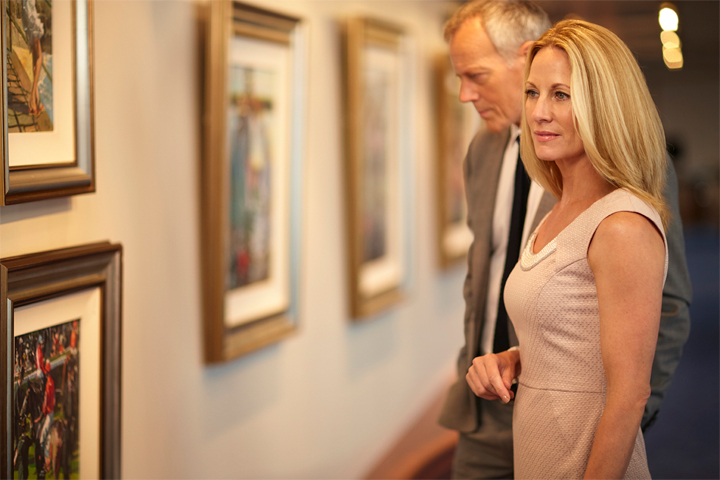
Art Gallery
- Card Room
- Casino
- Disco/Nightclub
- Movies
- Theater/Show Lounge
- Fitness Center
- Sauna/Steam Room
- Educational Programs
- Pool - Children's
- Pool - Outdoor
- Sports Facilities
- Whirlpool/Jacuzzi
- Art Gallery
- Bars/Lounges
- Library
- Children's Outdoor Play Area
- Organized Age Specific Activities
- Teen Center or Disco
- Teen Programs
- Business Center
- Concierge Desk
- Duty-Free Shops/Boutiques
- Elevators
- Safe Deposit Boxes
Activities & Services (available for an extra fee)

Spa
- Beauty Salon
- Full-Service Spa
- Internet Center
- Babysitting
- Dog Kennels
- Dry Cleaning/ Laundry Service
- Infirmary/Medical Center
- Self-Service Laundromat

Queens Grill
Main Dining
Queens Grill: Guests staying in the Queens Grill Suites have a table reserved in the Queens Grill Restaurant. You'll always be greeted warmly by name, and appreciate attentive service during breakfast, lunch and dinner. Dinner is served when you wish between 6:30 – 9 p.m.
Princess Grill: The sophisticated, intimate Princess Grill serves up excellent cuisine for breakfast, lunch, and dinner. Dinner is served when you wish between 6:30 – 9 p.m. To match your choice, a sommelier will gladly talk through the impressive wine list.
Britannnia Club Restaurant: The Britannia Club Restaurant boasts the same grandeur as the neighboring Britannia Restaurant, but with an intimate dining club atmosphere. Dine in the evening here whenever it suits you between 6:30 – 9 p.m.
Britannia Restaurant: Your table reservation is at Britannia Restaurant, where grandeur and occasion combine with exceptional service. Breakfast and lunch always feel special here and whether you've chosen to take your seat for dinner at 6 or 8:30 p.m., you can arrive with a flourish, down the steps of the curved staircase.

The Verandah
Specialty Dining
The Verandah: Steakhouse at The Verandah restaurant offers a sublime experience, whether it's lunch or dinner. Showcasing specialties such as prime USDA grain-finished New York strip steak and Alaskan king crab, alongside dishes celebrating British origin such as Salt Marsh lamb rack, as well as renowned Wagyu beef from farther afield. The menu is a celebration of the fine provenance of the US, British Isles and Australia. The Verandah takes design inspiration from the original Verandah Grill on board Queen Mary. This restaurant is available for an additional cost.

Kings Court
Casual Dining
Kings Court: Enjoy a casual breakfast, lunch, dinner or late-night buffet in the relaxed self-service Kings Court restaurant. With cuisine options that take inspiration from around the world, you’ll always find something to tempt you.
Golden Lion Pub: Darts, karaoke, live sports and ale – everything you’d expect of an authentic English pub. There’s even a traditional pub lunch served every day, with classic favorites such as fish and chips and cottage pie.
Sir Samuel's: Sweet-toothed epicures are invited to unwind in the elegant art deco surroundings of Sir Samuel's. Besides expertly-blended coffee and tea, you'll discover an exquisite variety of confectionery by master Belgian chocolatier Godiva. Deliberate over tempting pralines, sublime truffles, glistening macarons - or perhaps an ice cream made with intense dark chocolate? Finally - your tantalizing dilemma resolved - relax into sumptuous leather upholstery and reward yourself with the distinctive silky rich flavors of Godiva chocolate. This restaurant is available for an additional cost.
Carinthia Lounge: A tranquil retreat by day, the serene Carinthia Lounge provides the perfect place to relax and catch up with friends, or a good book, as well as enjoy light breakfast and lunch dishes along with premium teas and coffee and handmade patisseries. When the sun sets, the atmosphere evolves into an inviting evening spot where carefully selected wines are paired with tasting plates, and relaxed entertainment. This restaurant is available for an additional cost.
Queens Room: The elegant tradition of afternoon tea is a Cunard signature not to be missed. White-gloved waiters serve delightful cucumber sandwiches, fresh scones and tea accompanied by the sounds of the orchestra in the magnificent Queens Room ballroom.
Staterooms feature tasteful décor, a soft color palette and nightly turndown service.
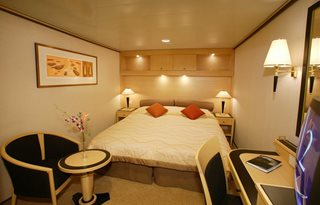
Category: IF
Area: Approximately 159-194 sq. ft.
With a variety of locations to choose from on board, our well-appointed inside staterooms are a haven of comfort and style to enjoy during your voyage. You'll find thoughtful features and luxurious amenities, all organized by your dedicated steward to ensure you are always attentively looked after.
Each Britannia Standard Inside stateroom includes:- Choice of Early, Late, and Open Dining in the Britannia Restaurant.
- Cunarder bed configurable to king-size or two single beds.
- Bathroom with a walk-in shower.
- Satellite TV with movie and music channels.
- Feature vanity and desk with hairdryer.
- UK, USA, and European power sockets.
- Penhaligon's toiletries.
- Bathrobes and slippers.
- Tea and coffee making facilities.
- Welcome sparkling wine.
- Complimentary room service menu.
- Mini-bar packages available for purchase.
- A dedicated steward to keep your stateroom in fine order day and night.

Category: IE
Area: Approximately 159-194 sq. ft.
With a variety of locations to choose from on board, our well-appointed inside staterooms are a haven of comfort and style to enjoy during your voyage. You'll find thoughtful features and luxurious amenities, all organized by your dedicated steward to ensure you are always attentively looked after.
Each Britannia Standard Inside stateroom includes:- Choice of Early, Late, and Open Dining in the Britannia Restaurant.
- Cunarder bed configurable to king-size or two single beds.
- Bathroom with a walk-in shower.
- Satellite TV with movie and music channels.
- Feature vanity and desk with hairdryer.
- UK, USA, and European power sockets.
- Penhaligon's toiletries.
- Bathrobes and slippers.
- Tea and coffee making facilities.
- Welcome sparkling wine.
- Complimentary room service menu.
- Mini-bar packages available for purchase.
- A dedicated steward to keep your stateroom in fine order day and night.

Category: IC
Area: Approximately 157-194 sq. ft.
With a variety of locations to choose from on board, our well-appointed inside staterooms are a haven of comfort and style to enjoy during your voyage. You'll find thoughtful features and luxurious amenities, all organized by your dedicated steward to ensure you are always attentively looked after.
Each Britannia Standard Inside stateroom includes:- Choice of Early, Late, and Open Dining in the Britannia Restaurant.
- Cunarder bed configurable to king-size or two single beds.
- Bathroom with a walk-in shower.
- Satellite TV with movie and music channels.
- Feature vanity and desk with hairdryer.
- UK, USA, and European power sockets.
- Penhaligon's toiletries.
- Bathrobes and slippers.
- Tea and coffee making facilities.
- Welcome sparkling wine.
- Complimentary room service menu.
- Mini-bar packages available for purchase.
- A dedicated steward to keep your stateroom in fine order day and night.

Category: IB
Area: Approximately 159-194 sq. ft.
With a variety of locations to choose from on board, our well-appointed inside staterooms are a haven of comfort and style to enjoy during your voyage. You'll find thoughtful features and luxurious amenities, all organized by your dedicated steward to ensure you are always attentively looked after.
Each Britannia Standard Inside stateroom includes:- Choice of Early, Late, and Open Dining in the Britannia Restaurant.
- Cunarder bed configurable to king-size or two single beds.
- Bathroom with a walk-in shower.
- Satellite TV with movie and music channels.
- Feature vanity and desk with hairdryer.
- UK, USA, and European power sockets.
- Penhaligon's toiletries.
- Bathrobes and slippers.
- Tea and coffee making facilities.
- Welcome sparkling wine.
- Complimentary room service menu.
- Mini-bar packages available for purchase.
- A dedicated steward to keep your stateroom in fine order day and night.

Category: IA
Area: Approximately 159 sq. ft.
With a variety of locations to choose from on board, our well-appointed inside staterooms are a haven of comfort and style to enjoy during your voyage. You'll find thoughtful features and luxurious amenities, all organized by your dedicated steward to ensure you are always attentively looked after.
Each Britannia Standard Inside stateroom includes:- Choice of Early, Late, and Open Dining in the Britannia Restaurant.
- Cunarder bed configurable to king-size or two single beds.
- Bathroom with a walk-in shower.
- Satellite TV with movie and music channels.
- Feature vanity and desk with hairdryer.
- UK, USA, and European power sockets.
- Penhaligon's toiletries.
- Bathrobes and slippers.
- Tea and coffee making facilities.
- Welcome sparkling wine.
- Complimentary room service menu.
- Mini-bar packages available for purchase.
- A dedicated steward to keep your stateroom in fine order day and night.
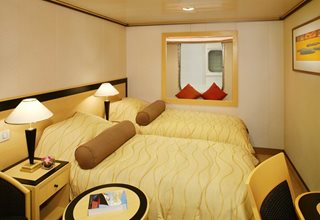
Category: HB
Area: Approximately 159 sq. ft.
With a view of Queen Mary 2's magnificent atrium, our well-appointed Atrium View Inside staterooms are a haven of comfort and style to enjoy during your voyage. You'll find thoughtful features and luxurious amenities, all organized by your dedicated steward to ensure you are always attentively looked after.
Each Britannia Standard Atrium View stateroom includes:- Choice of Early, Late, and Open Dining in the Britannia Restaurant.
- Cunarder bed configurable to king-size or two single beds.
- Bathroom with a walk-in shower.
- Satellite TV with movie and music channels.
- Feature vanity and desk with hairdryer.
- UK, USA, and European power sockets.
- Penhaligon's toiletries.
- Bathrobes and slippers.
- Tea and coffee making facilities.
- Welcome sparkling wine.
- Complimentary room service menu.
- Mini-bar packages available for purchase.
- A dedicated steward to keep your stateroom in fine order day and night.
- A window overlooking Queen Mary 2's atrium.
Luxurious staterooms feature elegant décor in soft, muted colors, an ocean view, 24-hour room service and nightly turndown service.
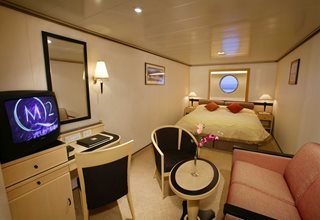
Category: EF
Area: Approximately 159-194 sq. ft.
Positioned to offer sea views, our Britannia Oceanview staterooms provide a private enclave from which to watch the world go by. Perfectly framed views are the backdrop to thoughtful features and luxurious amenities, all organized by your dedicated steward to ensure you are always attentively looked after.
Each Britannia Oceanview stateroom includes:- Choice of Early, Late, and Open Dining in the Britannia Restaurant.
- Lounge area with seating.
- Cunarder bed configurable to king-size or two single beds*
- Bathroom with a walk-in shower.
- Window with sea view.
- Satellite TV with movie and music channels.
- Feature vanity and desk with hairdryer.
- UK, USA, and European power sockets.
- Penhaligon's toiletries.
- Bathrobes and slippers.
- Tea and coffee making facilities.
- Welcome sparkling wine.
- Complimentary room service menu.
- Mini-bar packages available for purchase.
- A dedicated steward to keep your stateroom in fine order day and night.
Features a balcony with a seating area in a spacious stateroom featuring tasteful décor in soft, elegant tones.
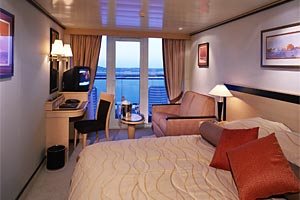
Category: DF
Area: Approximately 248 sq. ft.
Enjoy access to private, outdoor space in one of our obstructed view Britannia Balcony staterooms. You'll find thoughtful features and luxurious amenities, all organized by your dedicated steward to ensure you are always attentively looked after.
Each Britannia Balcony (obstructed view) stateroom includes:- Choice of Early, Late, and Open Dining in the Britannia Restaurant.
- Private balcony (obstructed view) with seating.
- Lounge area with seating.
- Cunarder bed configurable to king-size or two single beds.
- Bathroom with walk-in shower.
- Satellite TV with movie and music channels.
- Feature vanity and desk with hairdryer.
- UK, USA, and European power sockets.
- Penhaligon's toiletries.
- Bathrobes and slippers.
- Tea and coffee making facilities.
- Welcome sparkling wine.
- Complimentary room service menu.
- Mini-bar packages available for purchase.
- A dedicated steward to keep your stateroom in fine order day and night.

Category: DC
Area: Approximately 248 sq. ft.
Enjoy access to private, outdoor space in one of our obstructed view Britannia Balcony staterooms. You'll find thoughtful features and luxurious amenities, all organized by your dedicated steward to ensure you are always attentively looked after.
Each Britannia Balcony (obstructed view) stateroom includes:- Choice of Early, Late, and Open Dining in the Britannia Restaurant.
- Private balcony (obstructed view) with seating.
- Lounge area with seating.
- Cunarder bed configurable to king-size or two single beds.
- Bathroom with walk-in shower.
- Satellite TV with movie and music channels.
- Feature vanity and desk with hairdryer.
- UK, USA, and European power sockets.
- Penhaligon's toiletries.
- Bathrobes and slippers.
- Tea and coffee making facilities.
- Welcome sparkling wine.
- Complimentary room service menu.
- Mini-bar packages available for purchase.
- A dedicated steward to keep your stateroom in fine order day and night.

Category: DB
Area: Approximately 248 sq. ft.
Enjoy access to private, outdoor space in one of our obstructed view Britannia Balcony staterooms. You'll find thoughtful features and luxurious amenities, all organized by your dedicated steward to ensure you are always attentively looked after.
Each Britannia Balcony (obstructed view) stateroom includes:- Choice of Early, Late, and Open Dining in the Britannia Restaurant.
- Private balcony (obstructed view) with seating.
- Lounge area with seating.
- Cunarder bed configurable to king-size or two single beds.
- Bathroom with walk-in shower.
- Satellite TV with movie and music channels.
- Feature vanity and desk with hairdryer.
- UK, USA, and European power sockets.
- Penhaligon's toiletries.
- Bathrobes and slippers.
- Tea and coffee making facilities.
- Welcome sparkling wine.
- Complimentary room service menu.
- Mini-bar packages available for purchase.
- A dedicated steward to keep your stateroom in fine order day and night.
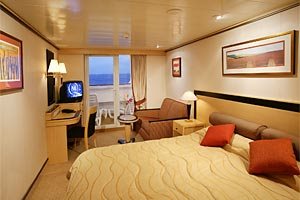
Category: BZ
Area: Approximately 269 sq. ft.
Enjoy access to private, outdoor space in one of our sheltered Britannia Balcony staterooms. You'll find thoughtful features and luxurious amenities, all organized by your dedicated steward to ensure you are always attentively looked after.
Each Britannia Balcony (sheltered) stateroom includes:- Choice of Early, Late, and Open Dining in the Britannia Restaurant.
- Sheltered private balcony with seating.
- Lounge area with seating.
- Cunarder bed configurable to king-size or two single beds.
- Bathroom with walk-in shower.
- Satellite TV with movie and music channels.
- Feature vanity and desk with hairdryer.
- UK, USA, and European power sockets.
- Penhaligon's toiletries.
- Bathrobes and slippers.
- Tea and coffee making facilities.
- Welcome sparkling wine.
- Complimentary room service menu.
- Mini-bar packages available for purchase.
- A dedicated steward to keep your stateroom in fine order day and night.

Category: BY
Area: Approximately 269 sq. ft.
Enjoy access to private, outdoor space in one of our sheltered Britannia Balcony staterooms. You'll find thoughtful features and luxurious amenities, all organized by your dedicated steward to ensure you are always attentively looked after.
Each Britannia Balcony (sheltered) stateroom includes:- Choice of Early, Late, and Open Dining in the Britannia Restaurant.
- Sheltered private balcony with seating.
- Lounge area with seating.
- Cunarder bed configurable to king-size or two single beds.
- Bathroom with walk-in shower.
- Satellite TV with movie and music channels.
- Feature vanity and desk with hairdryer.
- UK, USA, and European power sockets.
- Penhaligon's toiletries.
- Bathrobes and slippers.
- Tea and coffee making facilities.
- Welcome sparkling wine.
- Complimentary room service menu.
- Mini-bar packages available for purchase.
- A dedicated steward to keep your stateroom in fine order day and night.

Category: BV
Area: Approximately 269 sq. ft.
Enjoy access to private, outdoor space in one of our sheltered Britannia Balcony staterooms. You'll find thoughtful features and luxurious amenities, all organized by your dedicated steward to ensure you are always attentively looked after.
Each Britannia Balcony (sheltered) stateroom includes:- Choice of Early, Late, and Open Dining in the Britannia Restaurant.
- Sheltered private balcony with seating.
- Lounge area with seating.
- Cunarder bed configurable to king-size or two single beds.
- Bathroom with walk-in shower.
- Satellite TV with movie and music channels.
- Feature vanity and desk with hairdryer.
- UK, USA, and European power sockets.
- Penhaligon's toiletries.
- Bathrobes and slippers.
- Tea and coffee making facilities.
- Welcome sparkling wine.
- Complimentary room service menu.
- Mini-bar packages available for purchase.
- A dedicated steward to keep your stateroom in fine order day and night.

Category: BU
Area: Approximately 269 sq. ft.
Enjoy access to private, outdoor space in one of our sheltered Britannia Balcony staterooms. You'll find thoughtful features and luxurious amenities, all organized by your dedicated steward to ensure you are always attentively looked after.
Each Britannia Balcony (sheltered) stateroom includes:- Choice of Early, Late, and Open Dining in the Britannia Restaurant.
- Sheltered private balcony with seating.
- Lounge area with seating.
- Cunarder bed configurable to king-size or two single beds.
- Bathroom with walk-in shower.
- Satellite TV with movie and music channels.
- Feature vanity and desk with hairdryer.
- UK, USA, and European power sockets.
- Penhaligon's toiletries.
- Bathrobes and slippers.
- Tea and coffee making facilities.
- Welcome sparkling wine.
- Complimentary room service menu.
- Mini-bar packages available for purchase.
- A dedicated steward to keep your stateroom in fine order day and night.
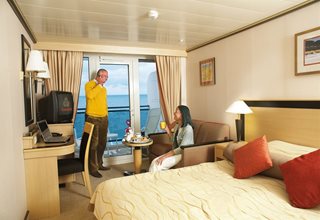
Category: BF
Area: Approximately 248 sq. ft.
Drink in sparkling sea views from your own private, outdoor space in one of our Britannia Balcony staterooms. You'll find thoughtful features and luxurious amenities, all organized by your dedicated steward to ensure you are always attentively looked after.
Each Britannia Balcony stateroom includes:- Choice of Early, Late, and Open Dining in the Britannia Restaurant.
- Private balcony with seating and sea views.
- Lounge area with seating.
- Cunarder bed configurable to king-size or two single beds.
- Bathroom with walk-in shower.
- Satellite TV with movie and music channels.
- Feature vanity and desk with hairdryer.
- UK, USA, and European power sockets.
- Penhaligon's toiletries.
- Bathrobes and slippers.
- Tea and coffee making facilities.
- Welcome sparkling wine.
- Complimentary room service menu.
- Mini-bar packages available for purchase.
- A dedicated steward to keep your stateroom in fine order day and night.

Category: BC
Area: Approximately 248 sq. ft.
Drink in sparkling sea views from your own private, outdoor space in one of our Britannia Balcony staterooms. You'll find thoughtful features and luxurious amenities, all organized by your dedicated steward to ensure you are always attentively looked after.
Each Britannia Balcony stateroom includes:- Choice of Early, Late, and Open Dining in the Britannia Restaurant.
- Private balcony with seating and sea views.
- Lounge area with seating.
- Cunarder bed configurable to king-size or two single beds.
- Bathroom with walk-in shower.
- Satellite TV with movie and music channels.
- Feature vanity and desk with hairdryer.
- UK, USA, and European power sockets.
- Penhaligon's toiletries.
- Bathrobes and slippers.
- Tea and coffee making facilities.
- Welcome sparkling wine.
- Complimentary room service menu.
- Mini-bar packages available for purchase.
- A dedicated steward to keep your stateroom in fine order day and night.

Category: BB
Area: Approximately 248 sq. ft.
Drink in sparkling sea views from your own private, outdoor space in one of our Britannia Balcony staterooms. You'll find thoughtful features and luxurious amenities, all organized by your dedicated steward to ensure you are always attentively looked after.
Each Britannia Balcony stateroom includes:- Choice of Early, Late, and Open Dining in the Britannia Restaurant.
- Private balcony with seating and sea views.
- Lounge area with seating.
- Cunarder bed configurable to king-size or two single beds.
- Bathroom with walk-in shower.
- Satellite TV with movie and music channels.
- Feature vanity and desk with hairdryer.
- UK, USA, and European power sockets.
- Penhaligon's toiletries.
- Bathrobes and slippers.
- Tea and coffee making facilities.
- Welcome sparkling wine.
- Complimentary room service menu.
- Mini-bar packages available for purchase.
- A dedicated steward to keep your stateroom in fine order day and night.
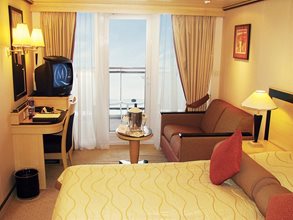
Category: A2
Area: Approximately 248 sq. ft.
Take advantage of prime sea views from your own private, outdoor space in one of our Britannia Club Balcony staterooms. You'll find thoughtful features, luxurious amenities and benefits, all organized by your dedicated steward to ensure you are always attentively looked after.
Each Britannia Club Balcony stateroom includes:- Access to the intimate Britannia Club restaurant with a reserved table throughout your voyage.
- Private balcony with seating and sea views.
- Lounge area with seating.
- Cunarder bed configurable to king-size or two single beds.
- Bathroom with walk-in shower.
- Satellite TV with movie and music channels.
- Feature vanity and desk with hairdryer.
- UK, USA, and European power sockets.
- Pillow concierge menu with a variety of types to choose from.
- Penhaligon's toiletries.
- Bathrobes and slippers.
- Specialty tea and coffee making facilities.
- Complimentary spring water replenished throughout your voyage.
- A welcome bottle of sparkling wine.
- Complimentary room service menu.
- Mini-bar packages available for purchase.
- A dedicated steward to keep your stateroom in fine order day and night.
- Priority embarkation and disembarkation.

Category: A1
Area: Approximately 248 sq. ft.
Take advantage of prime sea views from your own private, outdoor space in one of our Britannia Club Balcony staterooms. You'll find thoughtful features, luxurious amenities and benefits, all organized by your dedicated steward to ensure you are always attentively looked after.
Each Britannia Club Balcony stateroom includes:- Access to the intimate Britannia Club restaurant with a reserved table throughout your voyage.
- Private balcony with seating and sea views.
- Lounge area with seating.
- Cunarder bed configurable to king-size or two single beds.
- Bathroom with walk-in shower.
- Satellite TV with movie and music channels.
- Feature vanity and desk with hairdryer.
- UK, USA, and European power sockets.
- Pillow concierge menu with a variety of types to choose from.
- Penhaligon's toiletries.
- Bathrobes and slippers.
- Specialty tea and coffee making facilities.
- Complimentary spring water replenished throughout your voyage.
- A welcome bottle of sparkling wine.
- Complimentary room service menu.
- Mini-bar packages available for purchase.
- A dedicated steward to keep your stateroom in fine order day and night.
- Priority embarkation and disembarkation.
Spacious suites feature a separate seating area, a balcony and the Grills Experience. Select suites feature whirlpool bath and butler service.
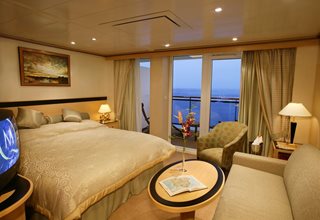
Category: P2
Area: Approximately 381 sq. ft.
Delight in magnificent sea views that can be enjoyed from both in and outside your Princess Suite. You'll find thoughtful features and luxurious amenities, all organized by your dedicated steward to ensure you are always attentively looked after.
Each Princess Suite includes:- Exclusive access to the Princess Grill restaurant, where you can dine any time at your reserved table.
- Private balcony with seating and sea views.
- Spacious lounge area with seating.
- Bedroom area with Cunarder bed configurable to king-size or two single beds.
- Pillow concierge menu with a variety of types to choose from.
- Bathroom with bath and shower.
- Satellite TV with movie and music channels in lounge and bedroom areas.
- Feature vanity and desk with hairdryer.
- UK, USA, and European power sockets.
- Penhaligon's toiletries.
- Luxury bathrobes and slippers.
- Feature mini-bar with specialty tea and coffee making facilities.
- Complimentary spring water replenished throughout your voyage.
- Mini-bar packages available for purchase.
- Welcome bottle of sparkling wine.
- Complimentary room service menu.
- Dine in-suite from the exquisite Princess Grill menu.
- Exclusive access to the Grills Lounge and outside Grills Terrace.
- Concierge service for on-board reservations and shore experiences.
- A dedicated steward to keep your suite in fine order day and night.
- Priority embarkation and disembarkation.

Category: P1
Area: Approximately 381 sq. ft.
Delight in magnificent sea views that can be enjoyed from both in and outside your Princess Suite. You'll find thoughtful features and luxurious amenities, all organized by your dedicated steward to ensure you are always attentively looked after.
Each Princess Suite includes:- Exclusive access to the Princess Grill restaurant, where you can dine any time at your reserved table.
- Private balcony with seating and sea views.
- Spacious lounge area with seating.
- Bedroom area with Cunarder bed configurable to king-size or two single beds.
- Pillow concierge menu with a variety of types to choose from.
- Bathroom with bath and shower.
- Satellite TV with movie and music channels in lounge and bedroom areas.
- Feature vanity and desk with hairdryer.
- UK, USA, and European power sockets.
- Penhaligon's toiletries.
- Luxury bathrobes and slippers.
- Feature mini-bar with specialty tea and coffee making facilities.
- Complimentary spring water replenished throughout your voyage.
- Mini-bar packages available for purchase.
- Welcome bottle of sparkling wine.
- Complimentary room service menu.
- Dine in-suite from the exquisite Princess Grill menu.
- Exclusive access to the Grills Lounge and outside Grills Terrace.
- Concierge service for on-board reservations and shore experiences.
- A dedicated steward to keep your suite in fine order day and night.
- Priority embarkation and disembarkation.
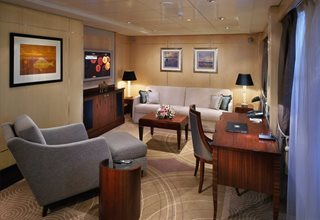
Category: Q7
Area: Approximately 506 sq. ft.
Retreat to an exclusive world of luxury with your own private residence at sea. Bold, striking colors and thoughtful designs bring each space in your suite to life. An attentive butler is on hand at all times to truly customize your voyage experience.
Each Queens Grill Suite includes:- Access to the exclusive Queens Grill restaurant, where you can dine any time at your reserved table.
- Spacious lounge area with seating.
- Bedroom area with Cunarder bed configurable to king-size or two single beds.
- Pillow concierge menu with a variety of types to choose from.
- Bathroom with bath and shower and separate dressing area.
- Spacious private balcony with seating and sea views.
- Satellite TV with movie and music channels in bedroom and lounge areas.
- Feature vanity and desk with hairdryer.
- Fresh flowers.
- Binoculars and world atlas to track your travels.
- UK, USA, and European power sockets.
- Penhaligon's toiletries.
- Luxury bathrobes and slippers.
- Complimentary mini-bar stocked with your choice of beer, wine, spirits, and soft drinks.
- Specialty tea and coffee making facilities.
- Daily fresh fruit.
- Pre-dinner canapés.
- Welcome bottle of Champagne.
- Complimentary room service menu.
- Dine in-suite from the exclusive Queens Grill menu.
- Exclusive access to the Grills Lounge and outside Grills Terrace.
- Concierge service for on-board reservations and shore experiences.
- A dedicated butler and steward to keep your suite in fine order day and night and host the perfect soirée.
- Priority embarkation and disembarkation.

Category: Q6
Area: Approximately 506 sq. ft.
Retreat to an exclusive world of luxury with your own private residence at sea. Bold, striking colors and thoughtful designs bring each space in your suite to life. An attentive butler is on hand at all times to truly customize your voyage experience.
Each Queens Grill Suite includes:- Access to the exclusive Queens Grill restaurant, where you can dine any time at your reserved table.
- Spacious lounge area with seating.
- Bedroom area with Cunarder bed configurable to king-size or two single beds.
- Pillow concierge menu with a variety of types to choose from.
- Bathroom with bath and shower and separate dressing area.
- Spacious private balcony with seating and sea views.
- Satellite TV with movie and music channels in bedroom and lounge areas.
- Feature vanity and desk with hairdryer.
- Fresh flowers.
- Binoculars and world atlas to track your travels.
- UK, USA, and European power sockets.
- Penhaligon's toiletries.
- Luxury bathrobes and slippers.
- Complimentary mini-bar stocked with your choice of beer, wine, spirits, and soft drinks.
- Specialty tea and coffee making facilities.
- Daily fresh fruit.
- Pre-dinner canapés.
- Welcome bottle of Champagne.
- Complimentary room service menu.
- Dine in-suite from the exclusive Queens Grill menu.
- Exclusive access to the Grills Lounge and outside Grills Terrace.
- Concierge service for on-board reservations and shore experiences.
- A dedicated butler and steward to keep your suite in fine order day and night and host the perfect soirée.
- Priority embarkation and disembarkation.

Category: Q5
Area: Approximately 506 sq. ft.
Retreat to an exclusive world of luxury with your own private residence at sea. Bold, striking colors and thoughtful designs bring each space in your suite to life. An attentive butler is on hand at all times to truly customize your voyage experience.
Each Queens Grill Suite includes:- Access to the exclusive Queens Grill restaurant, where you can dine any time at your reserved table.
- Spacious lounge area with seating.
- Bedroom area with Cunarder bed configurable to king-size or two single beds.
- Pillow concierge menu with a variety of types to choose from.
- Bathroom with bath and shower and separate dressing area.
- Spacious private balcony with seating and sea views.
- Satellite TV with movie and music channels in bedroom and lounge areas.
- Feature vanity and desk with hairdryer.
- Fresh flowers.
- Binoculars and world atlas to track your travels.
- UK, USA, and European power sockets.
- Penhaligon's toiletries.
- Luxury bathrobes and slippers.
- Complimentary mini-bar stocked with your choice of beer, wine, spirits, and soft drinks.
- Specialty tea and coffee making facilities.
- Daily fresh fruit.
- Pre-dinner canapés.
- Welcome bottle of Champagne.
- Complimentary room service menu.
- Dine in-suite from the exclusive Queens Grill menu.
- Exclusive access to the Grills Lounge and outside Grills Terrace.
- Concierge service for on-board reservations and shore experiences.
- A dedicated butler and steward to keep your suite in fine order day and night and host the perfect soirée.
- Priority embarkation and disembarkation.
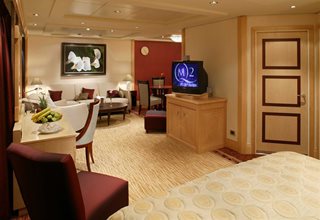
Category: Q4
Area: Approximately 758 sq. ft.
Retreat to an exclusive world of luxury with your own private residence at sea. Bold, striking colors and thoughtful designs bring each space in your suite to life. An attentive butler is on hand at all times to truly customize your voyage experience.
Each Queens Grill Penthouse includes:- Access to the exclusive Queens Grill restaurant, where you can dine any time at your reserved table.
- Spacious lounge area with seating.
- Bedroom area with Cunarder bed configurable to king-size or two single beds.
- Pillow concierge menu with a variety of types to choose from.
- Bathroom with bath and shower and separate dressing area.
- Spacious private balcony with seating and sea views.
- Satellite TV with movie and music channels in bedroom and lounge areas.
- Feature vanity and desk with hairdryer.
- Fresh flowers.
- Binoculars and world atlas to track your travels.
- UK, USA, and European power sockets.
- Penhaligon's toiletries.
- Luxury bathrobes and slippers.
- Complimentary mini-bar stocked with your choice of beer, wine, spirits, and soft drinks.
- Specialty tea and coffee making facilities.
- Daily fresh fruit.
- Pre-dinner canapés.
- Welcome bottle of Champagne.
- Complimentary room service menu.
- Dine in-suite from the exclusive Queens Grill menu.
- Exclusive access to the Grills Lounge and outside Grills Terrace.
- Concierge service for on-board reservations and shore experiences.
- A dedicated butler and steward to keep your suite in fine order day and night and host the perfect soirée.
- Priority embarkation and disembarkation.

Category: Q3
Area: Approximately 796 sq. ft.
Retreat to an exclusive world of luxury with your own private residence at sea. Bold, striking colors and thoughtful designs bring each space in your suite to life. An attentive butler is on hand at all times to truly customize your voyage experience.
Each Queens Grill Royal Suite includes:- Access to the exclusive Queens Grill restaurant, where you can dine any time at your reserved table.
- Spacious lounge area with seating.
- Bedroom area with Cunarder bed configurable to king-size or two single beds.
- Pillow concierge menu with a variety of types to choose from.
- Bathroom with bath and shower and separate dressing area.
- Satellite TV with movie and music channels in bedroom and lounge areas.
- Feature vanity with hairdryer.
- Writing desk with a set of personalized stationery.
- Fresh flowers.
- Binoculars and world atlas to track your travels.
- UK, USA, and European power sockets.
- Penhaligon's toiletries.
- Luxury bathrobes and slippers.
- Complimentary mini-bar stocked with your choice of beer, wine, spirits, and soft drinks.
- Specialty tea and coffee making facilities.
- Daily fresh fruit.
- Pre-dinner canapés.
- Welcome bottle of Champagne.
- Complimentary room service menu.
- Dine in-suite from the exclusive Queens Grill menu.
- Exclusive access to the Grills Lounge and outside Grills Terrace.
- Concierge service for on-board reservations and shore experiences.
- A dedicated butler and steward to keep your suite in fine order day and night and host the perfect soirée.
- Priority embarkation and disembarkation.
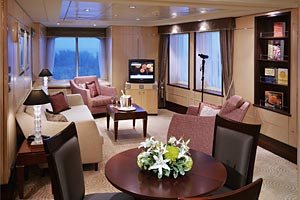
Category: Q2
Area: Approximately 1194-1566 sq. ft.
Retreat to an exclusive world of luxury with your own private residence at sea. Bold, striking colors and thoughtful designs bring each space in your suite to life. An attentive butler is on hand at all times to truly customize your voyage experience.
Each Queens Grill Duplex includes:- Access to the exclusive Queens Grill restaurant, where you can dine any time at your reserved table.
- Spacious lounge area with seating.
- Bedroom area with Cunarder bed configurable to king-size or two single beds.
- Pillow concierge menu with a variety of types to choose from.
- Twin marble bathrooms and two dressing areas.
- An expansive private deck, adjoined to the living area.
- Satellite TV with movie and music channels in bedroom and lounge areas.
- Feature vanity and desk with hairdryer.
- Fresh flowers.
- Binoculars and world atlas to track your travels.
- UK, USA, and European power sockets.
- An office with a set of personalized stationery.
- An exercise area with fitness equipment.
- Penhaligon's toiletries.
- Luxury bathrobes and slippers.
- Complimentary mini-bar stocked with your choice of beer, wine, spirits, and soft drinks.
- Butler's pantry.
- Specialty tea and coffee making facilities.
- Daily fresh fruit.
- Pre-dinner canapés.
- Welcome bottle of Champagne.
- Complimentary room service menu.
- Dine in-suite from the exclusive Queens Grill menu.
- Exclusive access to the Grills Lounge and outside Grills Terrace.
- Concierge service for on-board reservations and shore experiences.
- A dedicated butler and steward to keep your suite in fine order day and night and host the perfect soirée.
- Priority embarkation and disembarkation.
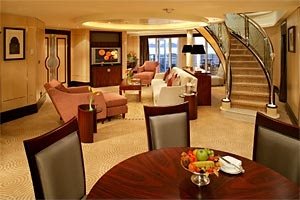
Category: Q1
Area: Approximately 2249 sq. ft.
Retreat to an exclusive world of luxury with your own private residence at sea. Bold, striking colors and thoughtful designs bring each space in your suite to life. An attentive butler is on hand at all times to truly customize your voyage experience.
The Queens Grill Grand Duplex includes:- Over 2,000 square feet of private living space, spread over two floors.
- Access to the exclusive Queens Grill restaurant, where you can dine any time at your reserved table.
- Spacious lounge area with seating.
- Dedicated dining area with room to host up to 8 guests.
- Bedroom area with Cunarder bed configurable to king-size or two single beds.
- Pillow concierge menu with a variety of types to choose from.
- Twin marble bathrooms and two dressing areas.
- An expansive private deck, adjoined to the living area.
- Satellite TV with movie and music channels in bedroom and lounge areas.
- Feature vanity and desk with hairdryer.
- Fresh flowers.
- Binoculars and world atlas to track your travels.
- UK, USA, and European power sockets.
- An office with a set of personalized stationery.
- An exercise area with fitness equipment.
- Butler's pantry.
- Penhaligon's toiletries.
- Luxury bathrobes and slippers.
- Complimentary mini-bar stocked with your choice of beer, wine, spirits, and soft drinks.
- Specialty tea and coffee making facilities.
- Daily fresh fruit.
- Pre-dinner canapés.
- Welcome bottle of Champagne.
- Complimentary room service menu.
- Dine in-suite from the exclusive Queens Grill menu.
- Exclusive access to the Grills Lounge and outside Grills Terrace.
- Concierge service for on-board reservations and shore experiences.
- A dedicated butler and steward to keep your suite in fine order day and night and host the perfect soirée.
- Priority embarkation and disembarkation.

| Symbol | Description |
|---|---|
 | Connecting staterooms |
 | Lift |
 | 3rd berth is a single sofabed |
 | 3rd & 4th berth is a double sofabed |
 | 3rd & 4th berths are two upper beds |
 | Staterooms have views obstructed by lifeboats |
 | Wheelchair accessible (stateroom sizes vary) |
 | Single-level Q2 Suite |
 | Royal Suites do not have balcony |
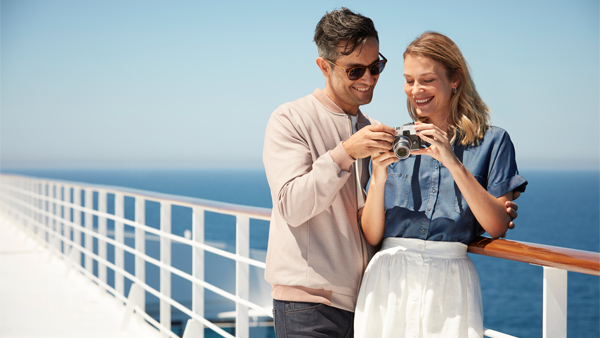
- Ship Name: Queen Mary 2
- Year Built: 2003
- Year Refurbished: 2016
- Year Entered Present Fleet: 2004
- Maximum Capacity: 2,691
- Number of Passenger Decks: 13
- Number of Crew: 1,292
- Officers' Nationality: British/International
- Ocean-View without Balcony: 76
- Ocean-View with Balcony: 813
- Total Inside Staterooms: 292
- Tonnage (GRT): 151,400
- Capacity Based on Double Occupancy: 2,676
- Country of Registry: Bermuda
- Total Staterooms: 1,353
- Suites with Balcony: 170
- Crew/Hotel Staff Nationality: International
Costco Member Reviews

Available Dates & Prices
Terms & Conditions
*Price shown is per person based on double occupancy and is valid for select stateroom categories only. Click on the Terms & Conditions link below for details.
†One Digital Costco Shop Card per room/stateroom, per stay. The exact amount of the Digital Costco Shop Card will be calculated during the booking process. The Digital Costco Shop Card promotion is nontransferable and may not be combined with any other promotion. A Digital Costco Shop Card will arrive by email approximately 10 days after the start of your cruise. Click on the Terms & Conditions link below for additional information.
© Carnival plc. Ships' Registry: Bermuda. The Cunard logo and logotype, Queen Mary 2, Queen Victoria, Queen Elizabeth, and Queen Anne are registered trademarks of Carnival plc, an English company trading as Cunard.
Digital Costco Shop Card
This booking includes a Digital Costco Shop Card which will arrive by email one to two weeks after you return from your vacation. The Digital Costco Shop Card is a convenient payment option in our warehouses and on Costco.com.


























